IMPACT 3D
3D printing technology to produce orthoses in Africa
From until
What
The IMP&ACTE 3D project explored how innovation, and in our specific case, how the use of 3D printing technology for the production of orthoses in West Africa, can improve access to physical rehabilitation services for the most vulnerable and isolated people in low-income and vulnerable humanitarian contexts.
It was implemented between November 2017 and April 2019 in three countries, Togo, Mali and Niger.
Goal
Specific technical target
- Identify appropriate 3D printing technology and 3D printers for use in this context.
- Test and identify 3D printing materials for the production of orthopedic devices.
- Determine a good set of 3D printing settings and strategies for the production of orthoses.
- Identify appropriate 3D scanner and 3D scanning software + computer hardware.
- Train OADCPH (Organization Africaine Pour Le Développement Des Centres Pour Personnes Handicapées) staff to prepare 3D models for 3D printing and to operate and maintain the 3D printer.
- Set up a Fablab facility with all necessary computer hardware in a controlled environment (temperature, humidity) and a stable power supply (backup generator, solar panels, ups …)
- Ensuring proper operation of the 3D printers.
- Train the clinical staff in the various orthopedic centers to use the 3D scanner and 3D scanning software instead of taking a plaster measure of the patient.
- Implement a digital correction process with CAD software for orthotists.
Specific clinical targets
- Verifying that the clinical impact of 3D printed lower leg orthoses is comparable to that of conventional orthoses.
- Evaluate patient satisfaction with conventional and 3D printed lower leg orthoses.
- Investigate the cost of 3D printed lower leg orthoses and the impact of implementing the new measurement and manufacturing workflow.
Relevance
In several regions of West Africa, care is not accessible or inadequate in remote rural areas, or in areas that are difficult to access due to conflict, for example. With the help of digital techniques such as 3D scanning and 3D modeling, patients in need of customized orthotics can receive better care at a distance. For example, the patient’s leg can be scanned by a person on site, while a trained orthopedic technologist can remotely design an orthopedic device that is then 3D-printed on site.
With recent advances in 3D printing technology, increasingly low-cost and widely deployable 3D printing applications are also becoming available that allow for the relatively low-cost printing of customized devices.
Our role
The role of the Mobilab & Care researchers was, on the one hand, to help implement a digital sizing and 3D printing workflow (establishing protocols and recommendations for scan sizing, digital design and 3D printing, research on material selection and printer settings), and, on the other hand, to set up a clinical study and process and analyze the collected data.
During the project, a digital workflow was rolled out in four orthopedic centers in Mali, Niger and Togo.
The digital design and 3D printing facility is done in a central location in Togo. Two FDM printers (Stacker S2 and an S4 FDM printer (Stacker LLC, Minneapolis)) were used to provide 90 patients with both a conventional and a 3D printed orthosis. They wore both at home for a minimum of two weeks.
Clinical study showed that for functional orthoses, both the 3D-printed and conventional orthoses provided improved walking speed. Similarly, in corrective orthoses, for both conventional and 3D-printed orthoses, they provided improvement in knee joint position deviation.
Future
The deployed equipment and infrastructure is still in use in the centers that participated in the project. With the knowledge gained, both Handicap International and Mobilab & Care have set up new projects that use low-threshold 3D printing technology in healthcare settings.
Researchers
Veerle Creylman
Loves to chat about orthoses, prosthetics and how to make them as optimal as possible, for every patient!
Tom Saey
Passionate about automation of personalised 3D design, 3D scanning and 3D printing in healthcare applications.
Partners







